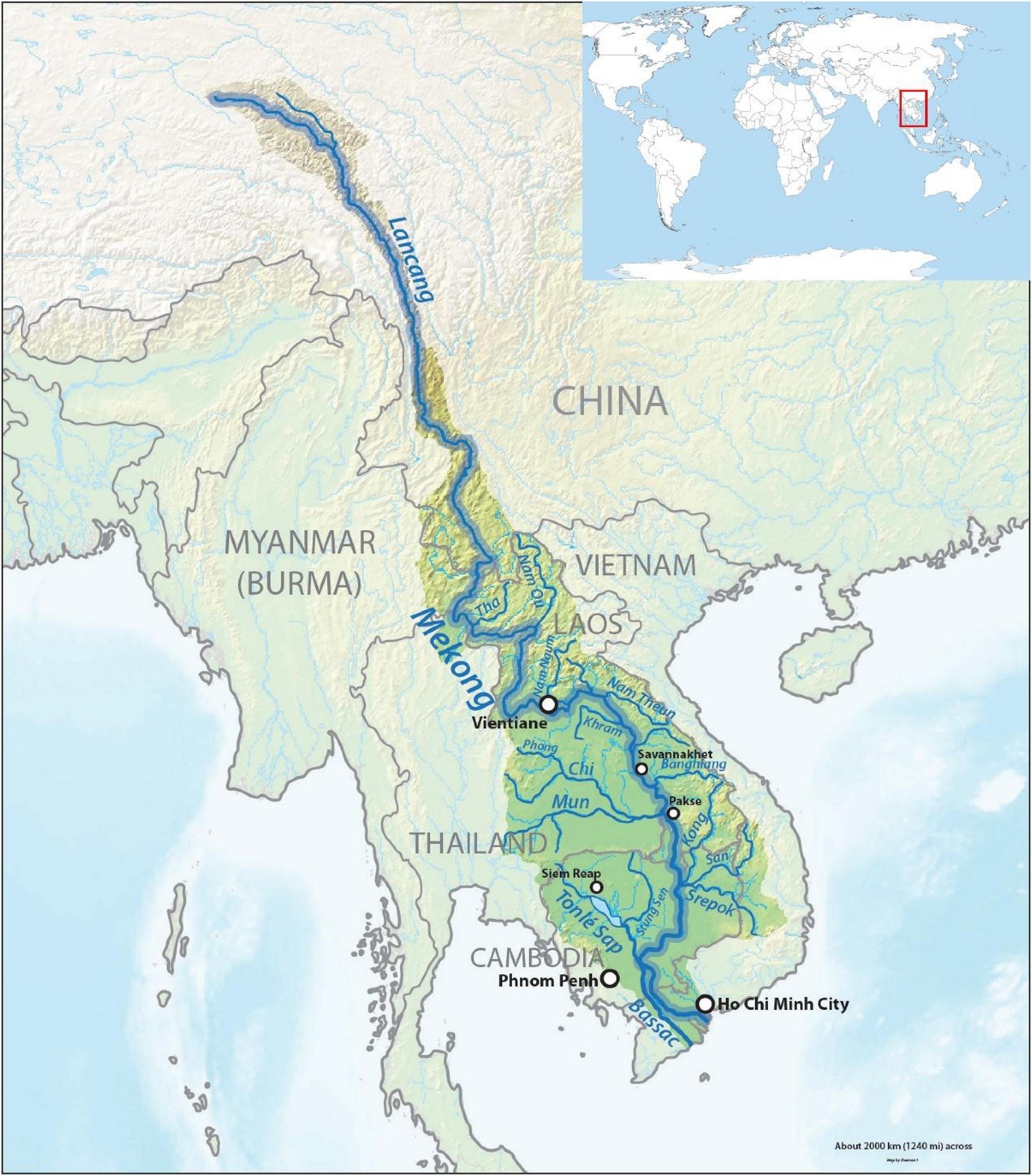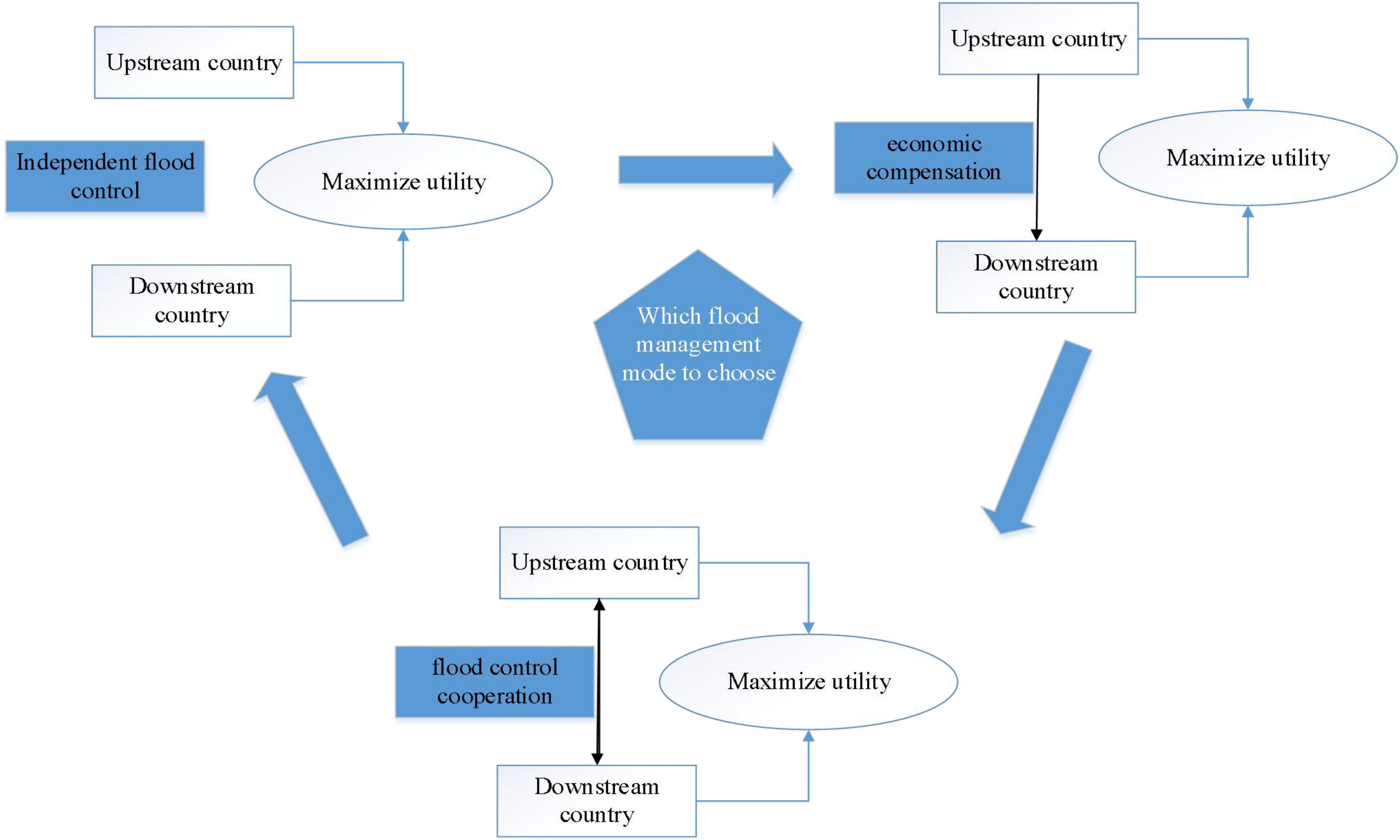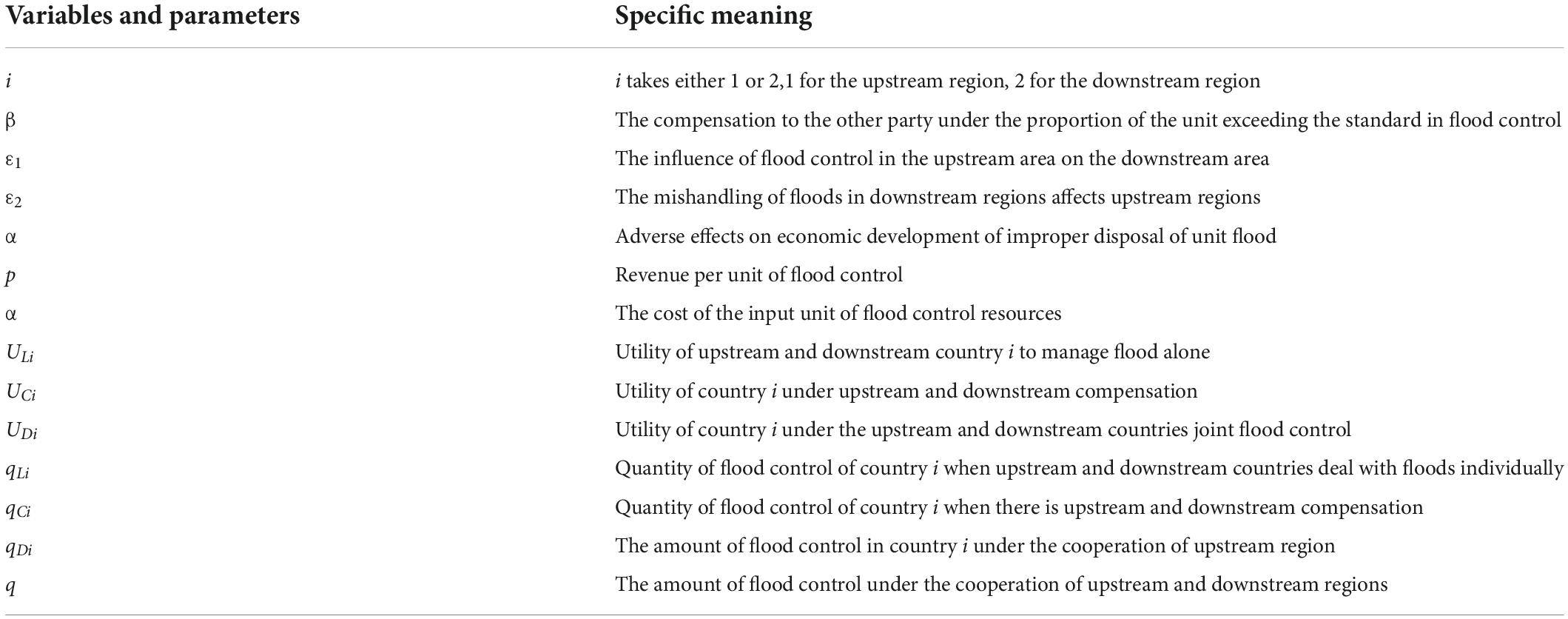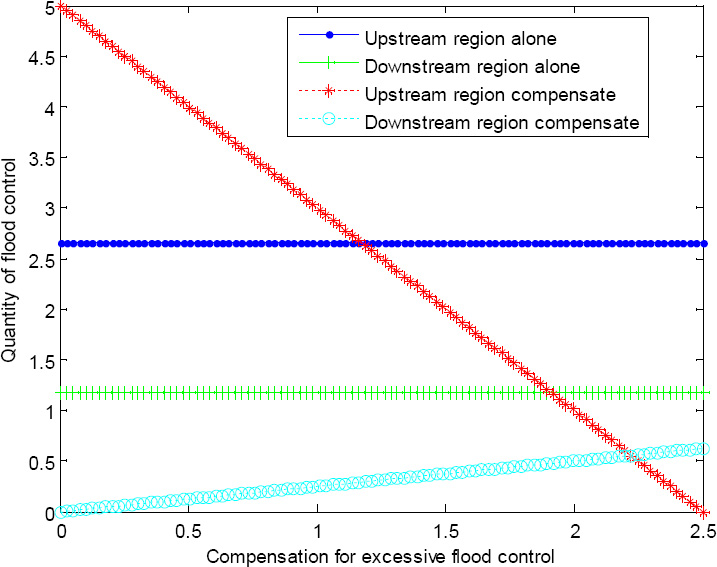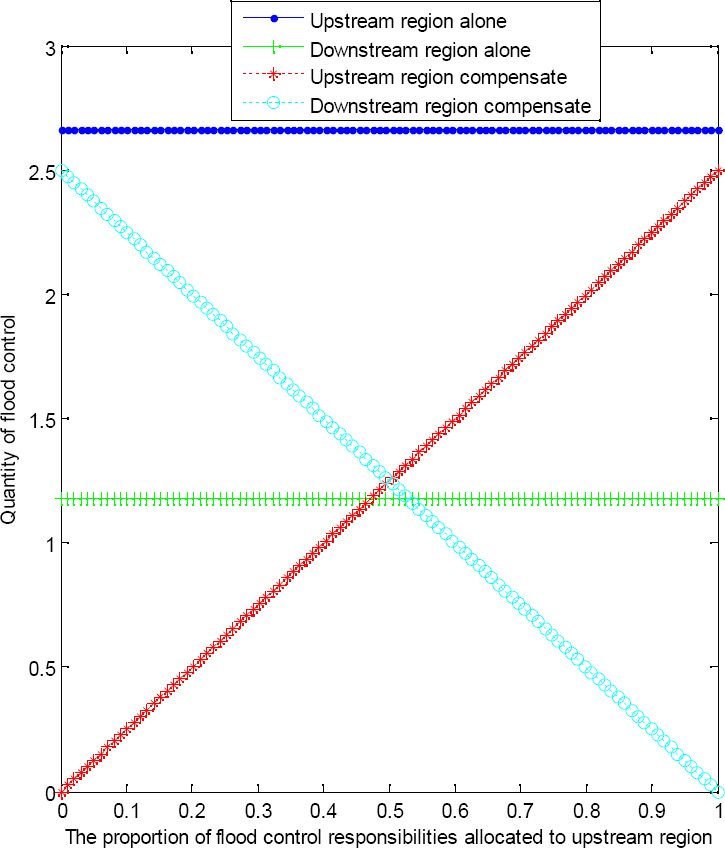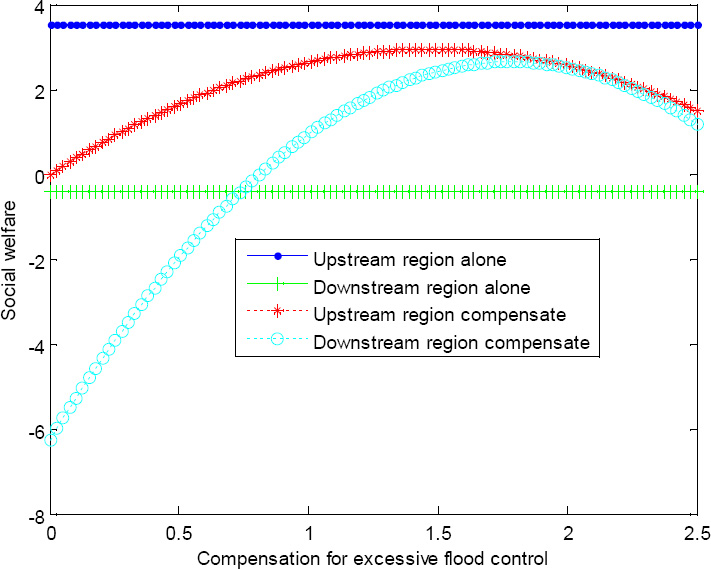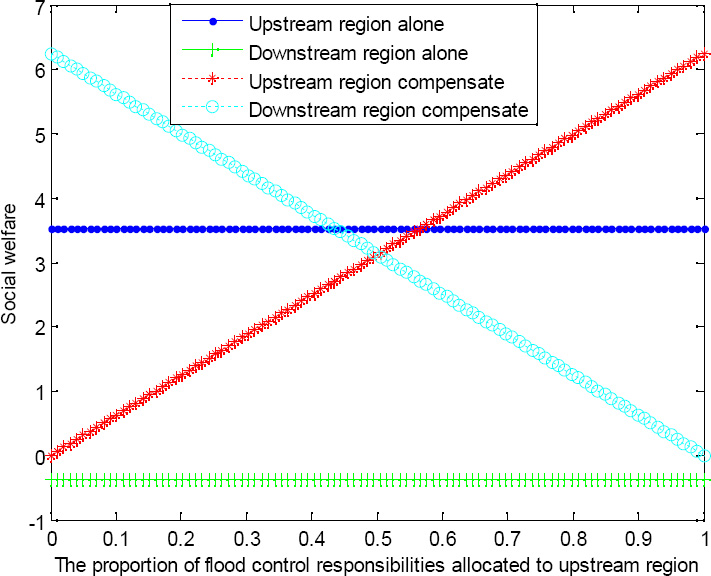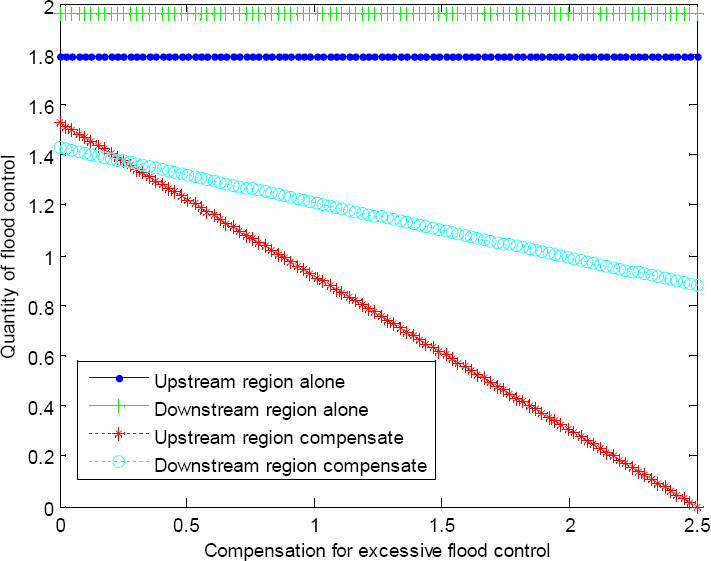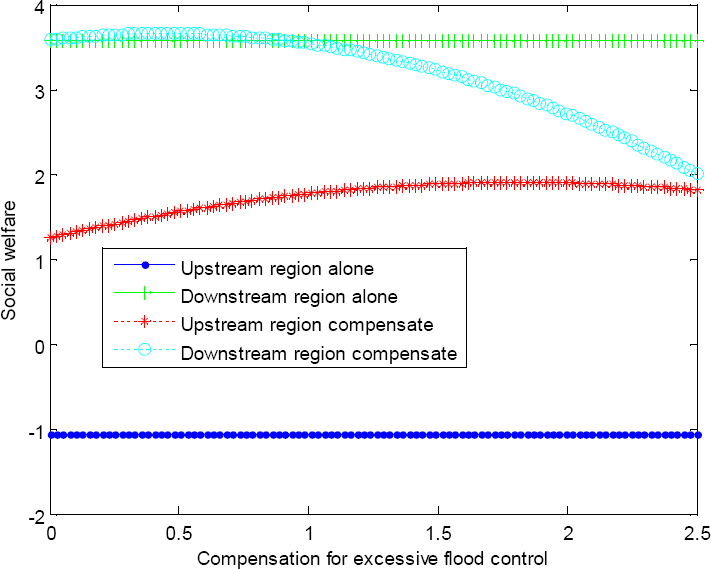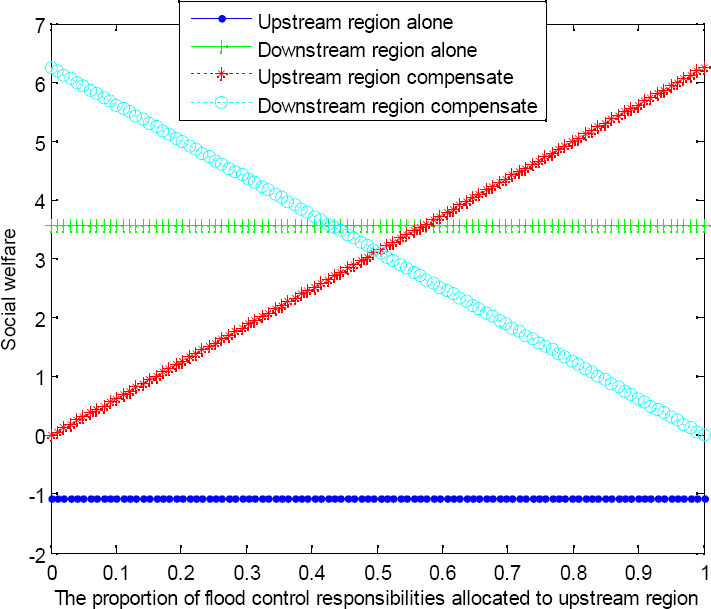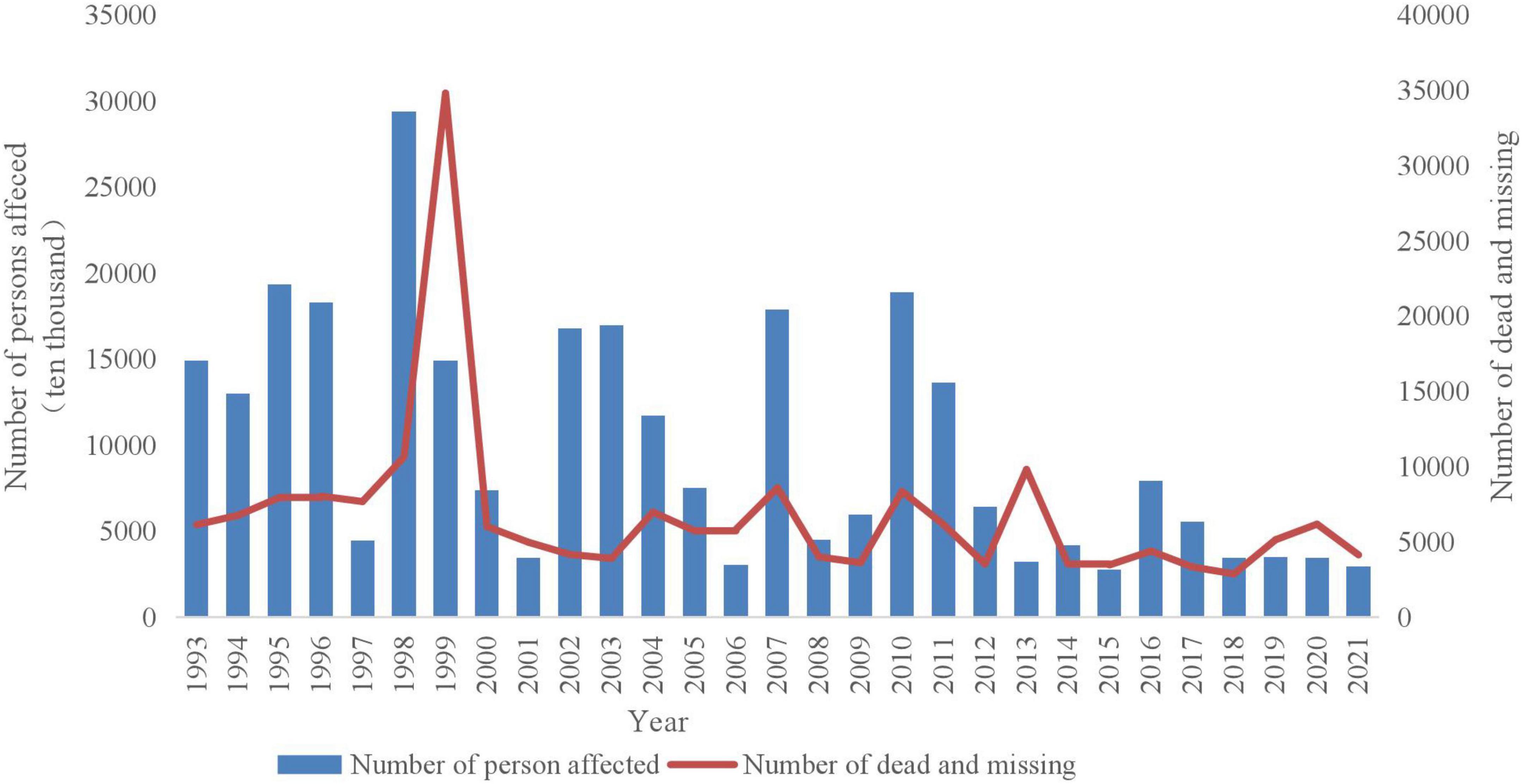- School of Business, Shandong Management University, Jinan, China
In face of more and more prominent problems of cross-border river flood disasters, the upstream and downstream need to strengthen cross-border flood disaster management cooperation. The authors set up a Stackelberg game model in the three scenarios of separate management/compensation management/joint governance between upstream and downstream flooding than get the Nash equilibrium under various conditions. An empirical analysis is carried out by taking the cooperative governance among countries in the Lancang–Mekong River Basin (LMRB) as an example. The conclusion shows that when flood control in the upstream region has a greater impact on the downstream region, with the increase of flood control compensation, flood control in the upstream region gradually decreases, while flood control in the downstream region gradually increases. And when the compensation amount is greater than the adverse impact of failure 2.22 times, the flood control of the downstream area will exceed that of the upstream area. When the compensation amount is greater than the adverse impact of failure 0.74 times, the social welfare of the downstream areas under cooperative flood control is greater than the social welfare under the flood control alone.
Introduction
There are 265 transnational shared rivers in the world, flowing through 150 global countries, with a basin area of 60.71 million square kilometers (Mulugeta et al., 2019). Because there are many transnational rivers on the earth, it is easy to cause a transnational flood problem. In recent years, with the intensification of global climate change, extreme weather has become more and more frequent (Wang J. et al., 2022). The boundaries of human production activities are also expanding (Wang and Yang, 2022). Floods often occur. Floods tend to lead to drought and subsequent famine in the land (Zhang et al., 2019). Heavy rains, snowmelt, melting ice, and dam breaks in reservoirs have caused increased water flow or a sharp rise in water levels in rivers, lakes, and oceans (Amor et al., 2019). When the nearby runoff arrives, the flow of the river begins to increase and the water level rises accordingly, which is called flood rising (Mas-Pla et al., 1999). Countries around the world must do more to protect themselves from floods (Meng et al., 2018).
If the flood is not handled properly, the ecological environment will be damaged (Nigussie et al., 2019). There is a special spatial and geographical relationship between the upstream and downstream regions, which leads to the fact that in the process of flood control of cross-border rivers, the upstream region can protect them from flooding as much as possible, while the downstream region is the latter to protect them from being hit by floods. The upstream region can manage the flood according to its own needs, and in this process, the interests of the downstream countries are often not considered, resulting in the loss of the interests of the downstream countries (Wang Q. et al., 2022). For example, Ethiopia believes that Egypt built dams to store water on its territory, which resulted in flood control of the Nile and damage to the ecological environment (Piao et al., 2010). The transboundary nature of international river flood control makes the scope of application of bilateral agreements signed by upstream and downstream countries more and more limited, and the coordination is more and more difficult. In the future, countries upstream and downstream of transnational rivers will gradually establish consultation mechanisms and flexibly use economic means.
In terms of influencing factors of a cross-border flood, most believe that floods are mainly due to melting glaciers, typhoons, rainfall, groundwater recharge, and other factors. For example, Mao et al. (2005) believe that climate has a great impact on water resources. Geertsema et al. (2022) obtained the relationship between flood disaster and rapid glacier retreat. TT et al. (2022) used SAR imagery to analyze the cause of flooding along Vietnam’s central coast. The results of Sidibé et al. (2019) proves that the mineralization and recharge of groundwater has a great impact on cross-border flood, Saraf and Regulwar (2016) studied the effect of precipitation on flood in Upper Godavari River Basin. Some scholars have proposed methods or measures to regulate or predict floods. The methods of flood prevention are mainly discussed from the technical aspect, while the measures of flood prevention are mainly carried out from the engineering level. For example, Zhou et al. (2022) believed that a conceptual hydrological model based on machine learning technology can be used to predict short-term flood probability density. Wu et al. (2019) believed that the water diversion project of the Han river and the Wei river can effectively solve the local flood control problem. Transnational floods often occur in transnational river basins. Transnational flood management is also a transnational water resources management problem in essence. In terms of cross-border river development and management, Rowland (2005) introduced sustainable common pool resource management on the quantity or quality of water resources in a crisis environment, and Raadgever et al. (2008) proposed the complexity of cross-border river development and management from the perspective of adaptive management. Guo et al. (2014) put forward the idea of the overall development and management of international rivers. Some scholars have studied how a country manages its floods. Iqbal et al. (2022) analyzed how to carry out flood control based on precipitation and soil data. Abdelal et al. (2021) studied the ancient Nabataean flood control system in Petra. In terms of the cooperative management of transnational rivers, Mccaffrey (2002) analyzed the cooperative exploitation of Euphrates and Tigris rivers. Bai et al. (2022) established a differential game model to analyze transnational water resources management in the LMRB (For convenience, the meanings of the abbreviations are given in Appendix Table A1, and same below). These studies cover basic theories on the development, distribution, and cooperation of cross-border rivers. The current trend of flood research is mainly to analyze the causes of flood formation, and what kind of technology and methods are used to control the flood. However, few scholars have studied flood control issues from the macro policies of upstream and downstream countries. Therefore, this study analyzes the governance effects of various modes, such as individual flood control, economic compensation, and joint governance, from the perspective of macro policies of upstream and downstream countries. This provides a reference for upstream and downstream countries to make macro flood management decisions.
Materials and methods
Due to the special spatial location of the upstream and downstream regions of cross-border rivers, the upstream countries can first regulate the floods according to their interests in the process of flood management. The upper reaches of transnational rivers lead the way. After flood control is completed in the upstream area, flood can be managed in the downstream area. They are followers. Stackelberg game is a price leadership model proposed by German economist Stackelberg in 1934. In this model, there are differences in the order of action of the two players. It is mainly applied to the duopoly dynamic game, that is, the leader acts first, the follower observes, and then decides his action according to the leader’s action. At present, research studies mainly focus on the location of anti-terrorism facilities (Berman and Gavious, 2007) and advertising strategies (Breton et al., 2006) and random supply chain (He et al., 2007), market competition (Julien and Tricou, 2012), and other fields. Through analysis, this paper concludes that few scholars use Stackelberg game model on the cross-border river upstream and downstream in the process of flood control. This article first considers cross-border river upstream and downstream between separate flood control, flood control compensation, joint control of flood, constructing a dynamic game model of the Stackelberg. It provides a reference for the control of transnational river floods. To express the geographical location of the study area more clearly, the location of the research area in this study is shown in Figure 1 (Lu et al., 2021).
For the convenience of discussion, this study assumes that there are two flood-prone areas in the cross-border river basin, namely, upstream area 1, and downstream area 2. Area 1 is the first actor and area 2 is the second actor. When there are multiple regions in a river basin, two upstream and downstream regions can be separately taken out for discussion on the basis of this study, and then the corresponding conclusions can be drawn.
This study assumes that the whole cross-border river is a complete ecosystem, and the flood disaster in one region not only has a negative impact on the ecology of the region but also may lead to ecological destruction in another region (He et al., 2012).
There are both dry and rainy seasons in cross-border rivers (Dorjsuren et al., 2018). This study focuses on the development and utilization of cross-border water resources in the case of floods in the rainy season, without considering the shortage of water resources in the dry season. Because this study focuses on the ecological problems such as the utilization of floods in the upstream and downstream of cross-region rather than the economic problems, in terms of cost, only the ecological cost caused by the utilization of floods is considered, and the development cost of water resources is not considered. This study takes no account of the factors affecting the price of water resources such as the demand for water resources, the level of economic development, and the income of residents in different upstream and downstream regions.
There are a variety of ways to deal with the flood disaster between the upstream and downstream regions across the region. The first is to deal with the flood separately in each region, the second is economic compensation in the upstream and downstream regions (the party dealing with more floods shall compensate the other party), and the third is to deal with the flood jointly in the upstream and downstream regions. Finally, this article also discusses which kind of flood control mode can achieve the maximum social benefits. The frame structure of the relationships between various flood control modes is shown in Figure 2.
Parameter setting
The quantity of flood control in the upstream and downstream regions is a decision variable. The main variables and parameters of this study are defined as shown in Table 1.
Different flood control modes
Individual management
Affected by heavy rains, typhoons, and other factors, floods frequently occur in the upstream and downstream areas (Abbas et al., 2013). There are dams and other facilities in the upstream and downstream areas. Both upstream and downstream countries can control the facilities in their region. This can prevent floods from affecting normal production and business activities (Sattar et al., 2019). In this case, the upstream region is the first mover and the downstream region is the last mover. For the sake of convenience, this study assumes that each flood control enterprise or resident cannot handle the flood disaster alone. All flooding in a region must be dealt with by the local government. Failure to properly handle the flood will lead to the destruction of the economic development and normal production and operation activities of residents (Meng et al., 2018). The results of flood management in one country will not only affect the country itself but also have an important impact on neighboring countries in the river basin. However, the impact on other countries is not as big as the impact on the country itself.
The social welfare function obtained by the upstream region is derived from the benefits of flood management and the costs of flood management. The social function obtained by the upstream region from the flood control is,
In Equation (1), pqL1 represents the benefits of flood management in the upstream region, qL1 represents the amount of flood control in the upstream region. ε2qL2 represents the amount of flood control in the downstream region. (qL1 + ε2qL2)2 represents the cost of flood control.
The social benefits of flood management in downstream countries are the same as those in upstream countries. The social function obtained by the downstream region in flood control is,
In Equation (2), pqL2 represents the benefits of flood control in the downstream region. qL2 represents the amount of flood control in the downstream region. And ε1qL1 represents the amount of flood reduction in the downstream region caused by flood control in the upstream region. (ε1qL1 + qL2)2 represents the cost of flood control.
Economic compensation
Ding and Wang (2012) uses simulation optimization methods to study flood mitigation. This differs from the study in this article, which examines how countries can cooperate to control floods. The flood control of trans-regional rivers is not only the objective result of human industrialization but also the result of the subjective pursuit of economic growth and industrial development in various regions. The flood problem is very prominent in many areas, so it is very important to control the flood effectively (Truslove et al., 2019). Some places do not manage the flood for their benefit. This will not only cause economic losses but also regional conflicts. Therefore, this study assumes the existence of a “super-regional” institution to internalize the problem of cross-border flood control (Cai et al., 2017).
The social welfare function obtained by the upstream region consists of the income obtained by the upstream region in flood control, the cost of dealing with floods, the compensation of the upstream country in flood control to the downstream country, and the compensation of the downstream region in flood control to the upstream country. The social function obtained by the upstream country in flood control is,
In Equation (3), pqC1 represents the benefits of flood control in the upstream region. (qC1 + ε2qC2)2 represents the cost of flood control. βqC1 represents the compensation for flood control in the upstream region to the downstream region, and βqC2 represents the compensation for flood control in the downstream region to the upstream region.
The social welfare function of the downstream region is derived from the benefits of the downstream country in flood control, the cost of flood control, the compensation of the downstream country in flood control to the upstream country, and the compensation of the upstream country in flood control to the downstream country. The social function of the downstream country in flood control is,
In Equation (4), pqC2 represents the benefits of flood control in the downstream region. ε1qC1 refers to the amount of flood water flowing from Country 1. (ε1qC1 + qC2)2 represents the cost of flood control. βqC1 represents the compensation for flood control in the upstream region to the downstream region, and βqC2 represents the compensation for flood control in the downstream region to the upstream region.
Joint management
To solve the negative externality of transnational rivers’ floods, it is necessary to rely on a series of binding regulatory measures, but the transboundary flood of transnational rivers makes it difficult for the downstream regions to “entrust” the upstream regions to regional regulations on the upstream country that caused the floods. If the upstream and downstream areas that frequently flood form an organization, the overall interests of all countries in a transnational river basin may be maximized. In 2010, countries in the Nile Valley (Ethiopia, Uganda, Tanzania, and Rwanda) signed the Nile cooperation framework agreement. One of the roles of the agreement is to deal with flooding. The new agreement calls for the creation of a permanent Nile basin commission, which would manage the water in its basin to control floods.
Under the joint flood control model of upstream and downstream regions, the total social welfare function is derived from the effectiveness and cost of flood control. The social function of the upstream and downstream regions’ flood control is,
In Equation (5), pq refers to the benefits brought by the upstream and downstream regions jointly controlling floods in the region. And αq2 refers to the flood control costs of the upstream and downstream regions jointly controlling floods.
Empirical analysis
The Lancang–Mekong river (LMR) is the ninth largest river in the world and the fifth largest river in Asia. It originates from the Tanggula Mountains in southern Qinghai Province, China. The river floods frequently during the flood season. In the LMRB, some areas are populated by large numbers of people and have a lot of infrastructures, while others are sparsely populated. The impact of flooding varies in different areas (Jie et al., 2022). In addition, the cost per unit flood is sometimes high and sometimes low. The LMRB distributes a large number of animal and plant habitats and natural landscapes (Bai et al., 2022), and flood control is easy to damage these habitats and natural landscapes. The influence of flood control, the price per unit of water, and the adverse impact of flood control on the ecology could further increase the magnitude and frequency of flooding in the basin. To accurately analyze how these factors affect the disasters caused by floods, this study sets these factors variable and then obtains more intuitive results in the next section.
Results
Equilibrium results
Individual management
Take the partial derivative of qL2 from Equation (2) and set it equal to zero to obtain:
By introducing the flood control amount of the optimal downstream region into the social welfare function of the upstream region, the following can be obtained:
Take the partial derivative of qL1 of Equation (7) and set it equal to zero, and we can get:
Substitute Equation (8) into Equation (6) to get,
Bring equations (8) and (9) into equations (1) and (2) to obtain the best social welfare in the upstream and downstream areas,
Conclusion 1: In the model of individual flood control in upstream and downstream areas, the greater the cost of the input unit of flood control resources, the less the flood control amount in the upstream area, the higher the benefits of flood control, and the more flood control in the upstream area.
Economic compensation
Take the partial derivative of qC2 from Equation (3) and set it equal to zero to obtain:
By introducing the flood control amount of the optimal downstream region into the social welfare function of the upstream region, the following can be obtained:
Take the partial derivative of qC1 with respect to Equation (13) and set it equal to zero to obtain:
If Equation (14) is substituted into Equation (12), we can get:
By substituting equations (14) and (15) into equations (3) and (4), the social welfare function of the upstream region can be obtained:
Conclusion 2: Under the flood control compensation model in the upstream and downstream regions, the greater the loss caused by the failure of effective flood control, the less flood control in the upstream regions, and the more flood control in the upstream regions.
Joint management
Taking the partial derivative of q with respect to Equation (5) and making it zero, we can get:
As a result,
Under the condition that upstream and downstream jointly flood control, their common social welfare function is:
Conclusion 3: Under the model of joint flood control in the upstream and downstream regions, the ecological loss caused by the failure of effective flood control is inversely proportional to the amount of flood control in the upstream and downstream regions, and the revenue per unit of flood control is directly proportional to the amount of flood control in the upstream and downstream regions. The ecological and economic loss caused by the lack of effective management of floods is inversely proportional to the social welfare of flood control in the upstream and downstream areas. The flood control unit is directly proportional to the social welfare of flood control in the upstream and downstream areas.
Empirical results
The revenue per unit of flood control in the LMRB is five, the influence of flood control in the upstream region on the downstream region is 0.5, the influence of flood control in the downstream region on the upstream country is 0.4, and the adverse impact of failure to control floods on the economic development of the unit is one.
When flood control in the upstream region has a greater impact on the downstream region, it can be seen from Figure 3 that with the increase of flood control compensation, flood control in the upstream region gradually decreases, while flood control in the downstream region gradually increases. And when the compensation amount is greater than the adverse impact of failure 2.22 times, the flood control of the downstream area will exceed that of the upstream area. As can be seen from Figure 4, under the mode of cooperative flood control, regardless of the proportion allocated to the upstream region, the flood control amount of the upstream region and the downstream region will be less than that of the upstream region.
When flood control in upstream areas has a greater impact on downstream areas, it can be seen from Figure 5 that with the increase in flood control compensation, social welfare in both upstream and downstream areas will increase first and then decrease. When the compensation amount is greater than the adverse impact of failure 0.74 times, the social welfare of the downstream areas under cooperative flood control is greater than the social welfare under the flood control alone. As can be seen from Figure 6, under the model of cooperative flood control, the social welfare of the upstream and downstream regions will be greater than that of the downstream regions in controlling floods alone, regardless of the proportion of allocation to the upstream regions.
If the values of other parameters remain unchanged, the influence of flood control in the upstream region on the downstream region would be 0.3, and the influence of flood control in the downstream region on the upstream country would be 0.7. The impact of flood control and flood control compensation amount on flood control, the impact of flood control proportion on flood control in upstream countries, the impact of flood control and flood control compensation amount on social welfare, and the impact of flood control proportion on social welfare in upstream countries are shown in Figures 7–10, respectively.
As shown in Figure 7, with the increase in flood control compensation between the upper and lower reaches in the LMRB, the proportion of flood control development in the upstream and downstream regions gradually decreases, and when the compensation is greater than a certain value, flood control in the downstream regions is greater than that in the upstream regions. As can be seen from Figure 8, under the model of cooperative flood control, when the proportion of flood control responsibilities allocated to the upstream area is greater than a certain value, the quantity of joint flood control by the upstream area is greater than the quantity of flood control alone by the upstream area.
When the influence of flood control in the upstream region on the downstream region is relatively small, it can be seen from Figure 9 that with the increase in flood control compensation, the social welfare of the upstream region increases first and then becomes stable. The social welfare in the downstream areas is stable first and then reduced. The compensation amount is small, the governance flooding downstream of the social welfare is greater than the single mode of social welfare governance flooding, with the increasing of the amount of compensation, but as governance flooding downstream of the social welfare than separate governance flooding mode of social welfare, but no matter how change governance flood compensation amount, flood upstream region governance mode of the social welfare are greater than single governance flooding mode of social welfare. As can be seen from Figure 10, under the model of cooperative flood control, no matter what proportion is allocated to the upstream region, the amount of flood control in the upstream region and the downstream region will be greater than the amount of flood control in the upstream region alone.
Discussion
If upstream countries did more to control flooding within their borders, downstream countries would suffer less flooding. Strengthening the cooperation between upstream and downstream countries in flood control is not only conducive to the economic growth and stability of basin countries but also conducive to the new development of basin countries in regional economic cooperation. For example, when floods broke out on the LMR in 2017, China conducted inspections and emergency response at construction sites. This ensures the normal operation of diversion works, flood control facilities, drainage facilities, and ditches. Finally, China ensured flood control on the LMR (La, 2017). This effectively prevented the impact of floods on the lower reaches of the LMR.
In the process of economic compensation or joint governance of upstream and downstream countries, the upstream countries will not increase flood control efforts even if flood control failures cause huge losses to the downstream countries. This is mainly because sudden floods can cause huge damage. And such floods are difficult to predict and prevent, increasing the difficulty of treatment. In this case, upstream and downstream countries will reduce flood control efforts. For example, in dealing with floods in the Danube Valley in 2004, the International Commission for the Protection of the Danube River (ICPDR) issued the Action Program for Sustainable Flood Protection in the Danube River, which combines water pollution control and flood control management. But 2 years after the project began, the Tissa, Sava, and Grand Morava rivers in the Upper Danube Basin flooded almost simultaneously due to short periods of heavy rainfall. The Danube river, which stretches for 1,000 km, suffered the worst flood in 100 years, causing great damage to countries along the Danube river basin. In 2010, scattered rainfall throughout the year spread over much of the Danube river basin, resulting in a high frequency of catastrophic flooding events with 35 deaths and economic losses of two billion euros (Haupter et al., 2005).
In the process of cooperation between upstream and downstream countries in flood control, upstream countries need to shoulder more responsibilities. If upstream countries take more action to manage floods, downstream countries will need to invest fewer resources to contain the impact of floods. Strengthening the cooperation between upstream and downstream countries in flood control is not only conducive to the economic growth and stability of basin countries but also conducive to the new development of basin countries in regional economic cooperation. For example, in the process of flood control in the LMRB, upstream and downstream countries cooperated, and issued the Lancang–Mekong Cooperation (LMC) 5-Year Action Plan (2018–2022) and Phnom Penh Declaration of the Second LMC Leaders’ Meeting in 2018. China, at the upper reaches of the LMR, has also made more efforts, for example, by building dams on the river since 2012 that have largely limited the river’s natural flow and reduced flooding in the region. With flood control in various countries, the number of people affected by floods is also decreasing. The change in the impact of floods on human beings is shown in Figure 11 (Data resource: Global Disaster Data Platform).
Different from the specific measures of flood control studied by other scholars (Iqbal et al., 2022), this study mainly analyzed the form of cooperation between upstream and downstream countries from the perspective of which cooperation mode should be adopted. The occurrence of the flood is caused by both the destruction of the ecological environment and sudden factors. However, the sudden factors leading to the occurrence of floods cannot be controlled artificially. As a result, it is difficult to prevent floods. Therefore, this study analyzed from the perspective of upstream and downstream countries’ cooperation in flood control and obtained which cooperative governance mode can achieve greater benefits.
Conclusion
Flood is one of the most common natural disasters. Floods flowing through upstream countries will affect the ecological environment and economic development of downstream countries, and no country in a river basin is immune. The flood control modes of upstream and downstream countries mainly include three types, namely, flood control independently, compensating for flood control, and cooperating with upstream and downstream to flood control. Most of the existing studies on transboundary river flood disasters adopt game methods such as evolutionary games, repeated games, and differential games. A few scholars consider the Stackelberg game, and a few others compare and analyze different flood management methods.
This study assumes that considering the spatial position relationship between the upstream and downstream of the cross-border river, flood control should be carried out in the upstream area and the downstream area first, and constructs the Stackelberg game model under three water resources development and utilization modes. The results show that when flood control in the upstream region has a greater impact on the downstream region, with the increase of flood control compensation, flood control in the upstream region gradually decreases, while flood control in the downstream region gradually increases. And when the compensation amount is greater than the adverse impact of failure 2.22 times, the flood control of the downstream area will exceed that of the upstream area. When the compensation amount is greater than the adverse impact of failure 0.74 times, the social welfare of the downstream areas under cooperative flood control is greater than the social welfare under the flood control alone.
Of course, this study also has some drawbacks. For example, this study only assumes the existence of two regions in the upstream and downstream and does not consider the existence of multiple regions. In future studies, the existence of multiple regions can be considered to study related issues. In addition, the research of this study is not only applicable to the upstream and downstream development and management of flood resources but also has certain reference significance to transnational flood control and other related issues.
Data availability statement
The original contributions presented in this study are included in the article/supplementary material, further inquiries can be directed to the corresponding author.
Author contributions
QW: conceptualization, methodology, validation, formal analysis, investigation, writing—original draft preparation, and visualization. YB: funding acquisition, supervision, validation, formal analysis, investigation, and writing—original draft preparation. YY: resources, data curation, writing—review and editing, supervision, project administration, and funding acquisition. All authors were involved in preparing the manuscript.
Conflict of interest
The authors declare that the research was conducted in the absence of any commercial or financial relationships that could be construed as a potential conflict of interest.
Publisher’s note
All claims expressed in this article are solely those of the authors and do not necessarily represent those of their affiliated organizations, or those of the publisher, the editors and the reviewers. Any product that may be evaluated in this article, or claim that may be made by its manufacturer, is not guaranteed or endorsed by the publisher.
References
Abbas, F., Ahmad, A., Safeeq, M., Ali, S., Saleem, F., Hammad, H. M., et al. (2013). Changes in precipitation extremes over arid to semiarid and subhumid Punjab, Pakistan. Theor. Appl. Climatol. 116, 671–680. doi: 10.1007/s00704-013-0988-8
Abdelal, Q., Al-Rawabdeh, A., Qudah, K. A., Hamarneh, C., and Qudah, A. (2021). Hydrological assessment and management implications for the ancient Nabataean flood control system in Petra, Jordan. J. Hydrol. 601:126583. doi: 10.1016/j.jhydrol.2021.126583
Amor, C., Marchão, L., Lucas, M. S., and Peres, J. A. (2019). Application of advanced oxidation processes for the treatment of recalcitrant agro-industrial wastewater: A review. Water 11:205. doi: 10.3390/w11020205
Bai, Y., Wang, Q., and Yang, Y. (2022). From pollution control cooperation of Lancang-Mekong River to “Two Mountains Theory”. Sustainability 14:2392. doi: 10.3390/su14042392
Berman, O., and Gavious, A. (2007). Location of terror response facilities: A game between state and terrorist. Eur. J. Oper. Res. 177, 1113–1133. doi: 10.1016/j.ejor.2005.12.022
Breton, M., Jarrar, R., and Zaccour, G. (2006). A note on feedback sequential equilibria in a lanchester model with empirical application. Manag. Sci. 52, 804–811. doi: 10.1287/mnsc.1050.0475
Cai, B., Wang, X., and Li, Y. (2017). Application of a double-sided chance-constrained integer linear program for optimization of the incremental value of ecosystem services in Jilin Province, China. Water 9:629. doi: 10.3390/w9080629
Ding, Y., and Wang, S. S. (2012). Optimal control of flood diversion in watershed using nonlinear optimization. Adv. Mater. Res. 44, 30–48. doi: 10.1016/j.advwatres.2012.04.004
Dorjsuren, B., Yan, D., Wang, H., Chonokhuu, S., Enkhbold, A., Yiran, X., et al. (2018). Observed trends of climate and river discharge in Mongolia’s Selenga Sub-Basin of the Lake Baikal Basin. Water 10:1436. doi: 10.3390/w10101436
Geertsema, M., Menounos, B., Bullard, G., Carrivick, J. L., Clague, J. J., Dai, C., et al. (2022). The 28 November 2020 landslide, tsunami, and outburst flood – a hazard cascade associated with rapid deglaciation at Elliot Creek, British Columbia, Canada. Geophys. Res. Lett. 49:e2021GL096716. doi: 10.1029/2021GL096716
Guo, S. Z., Wang, Q. P., and Hou, M. M. (2014). A discussion on the construction of information integration based on the integrated development and management of international river. Adv. Mater. Res. 989-994, 5267–5272. doi: 10.4028/www.scientific.net/AMR.989-994.5267
Haupter, B., Heiland, P., and Jürgen, N. (2005). Interregional and Transnational Co-operation in River Basins – Chances to Improve Flood Risk Management? Nat. Hazards 36, 5–24. doi: 10.1007/s11069-004-4536-9
He, J., Wang, J., and Sun, L. (2012). On game behavior of the inventory pledge banks and the logistical enterprises. Adv. Mater. Res. 46, 2223–2226. doi: 10.4028/www.scientific.net/AMR.468-471.2223
He, X., Prasad, A., Sethi, S. P., and Gutierrez, G. J. (2007). A survey of Stachelberg differential game models in supply and marketing channels. J. Syst. Sci. Syst. Eng. 16, 385–413. doi: 10.1007/s11518-007-5058-2
Iqbal, A., Rahman, M. M., and Beecham, S. (2022). Permeable pavements for flood control in Australia: Spatial analysis of pavement design considering rainfall and soil data. Sustainability 14:4970. doi: 10.3390/su14094970
Jie, W., Tang, Q., Yun, X., Chen, A., Sun, S., and Yamazaki, D. (2022). Flood inundation in the Lancang-Mekong River Basin: assessing the role of summer monsoon. J. Hydrol. 612:128075. doi: 10.1016/j.jhydrol.2022.128075
Julien, L. A., and Tricou, F. (2012). Market price mechanisms and Stackelberg general equilibria: An example. Bull. Econ. Res. 64, 239–252. doi: 10.1111/j.1467-8586.2010.00362.x
La, L. (2017). The Lancang River Basin In Deqin County Suffered Severe Floods. Quarry Bay: Shangri-la net.
Lu, Y., Tian, F., Guo, L., Borzi, I., Patil, R., Wei, J., et al. (2021). Socio-hydrologic modeling of the dynamics of cooperation in the transboundary Lancang-Mekong River. Hydrol. Earth Syst. Sci. 25, 1883–1903. doi: 10.5194/hess-25-1883-2021
Mao, J., Wang, Y., Zhao, Q., and Wu, X. (2005). Preliminary study on phosphorus release of internal load in dianchi lake sediment. J. China Inst. Water Resour. Hydropower Res. 3, 229–233.
Mas-Pla, J., Montaner, J., and Solá, J. (1999). Groundwater resources and quality variations caused by gravel mining in coastal streams. J. Hydrol. 216, 197–213. doi: 10.1016/S0022-1694(99)00009-8
Mccaffrey, S. C. (2002). Peaceful uses of international rivers: The euphrates and tigris rivers dispute. Am. J. Int. Law 97, 469–474. doi: 10.2307/3100133
Meng, C., Wang, X., and Li, Y. (2018). An optimization model for water management based on water resources and environmental carrying capacities: A case study of the Yinma River Basin, Northeast China. Water 10:565. doi: 10.3390/w10050565
Mulugeta, S., Fedler, C., and Ayana, M. (2019). Analysis of long-term trends of annual and seasonal rainfall in the Awash River Basin, Ethiopia. Water 11:1498. doi: 10.3390/w11071498
Nigussie, G., Moges, M. A., Moges, M. M., and Steenhuis, T. S. (2019). Assessment of suitable land for surface irrigation in ungauged catchments: Blue Nile Basin, Ethiopia. Water 11:1465. doi: 10.3390/w11071465
Piao, S., Ciais, P., Huang, Y., Shen, Z., Peng, S., and Li, J. (2010). The impacts of climate change on water resources and agriculture in China. Nature 467, 43–51. doi: 10.1038/nature09364
Raadgever, G. T., Erik, M., Nicole, K., and Interwies, E. (2008). Assessing management regimes in transboundary river basins: Do They support adaptive management? Ecol. Soc. 13:14. doi: 10.5751/ES-02385-130114
Rowland, M. (2005). A framework for resolving the transboundary water allocation conflict conundrum. Groundwater 43, 700–705. doi: 10.1111/j.1745-6584.2005.00066.x
Saraf, V. R., and Regulwar, D. G. (2016). Assessment of climate change for precipitation and temperature using statistical downscaling methods in Upper Godavari River Basin, India. J. Water Resour. Prot. 8, 31–45. doi: 10.4236/jwarp.2016.81004
Sattar, A. M. A., Bonakdari, H., Gharabaghi, B., and Radecki-Pawlik, A. (2019). Hydraulic modeling and evaluation equations for the incipient motion of sandbags for levee breach closure operations. Water 11:279. doi: 10.3390/w11020279
Sidibé, A. M., Lin, X., and Koné, S. (2019). Assessing Groundwater Mineralization Process, Quality, and Isotopic Recharge Origin in the Sahel Region in Africa. Water 11:789. doi: 10.3390/w11040789
Truslove, J. P., Miller, A. V. M., Mannix, N., Nhlema, M., Rivett, M. O., Coulson, A. B., et al. (2019). Understanding the functionality and burden on decentralised rural water supply: Influence of millennium development goal 7c coverage targets. Water 11:494. doi: 10.3390/w11030494
TT, L., Froger, J. L., and Minh, D. (2022). Multiscale framework for rapid change analysis from SAR image time series: Case study of flood monitoring in the central coast regions of Vietnam. Remote Sens. Environ. 269:112837. doi: 10.1016/j.rse.2021.112837
Wang, J., Tang, Q., Chen, A., Tang, Y., Xu, X., Yun, X., et al. (2022). Impacts of summer monsoons on flood characteristics in the Lancang-Mekong River Basin. J. Hydrol. 604:127256. doi: 10.1016/j.jhydrol.2021.127256
Wang, Q., Yu, L., Yang, Y., Zhao, H., Song, Y., Song, W., et al. (2022). Let the Farmers Embrace “Carbon Neutrality”: Taking the Centralized Biogas as an Example. Int. J. Environ. Res. Public Health 19:9677. doi: 10.3390/ijerph19159677
Wang, Q., and Yang, Y. (2022). From Passive to Active: The Paradigm Shift of Straw Collection. Front. Ecol. Evol. 10:3389. doi: 10.3389/fevo.2022.945646
Wu, L., Bai, T., Huang, Q., Wei, J., and Liu, X. (2019). Multi-Objective optimal operations based on improved NSGA-II for Hanjiang to Wei River water diversion project, China. Water 11:1159. doi: 10.3390/w11061159
Zhang, Q., Yu, R., Jin, Y., Zhang, Z., Liu, X., Xue, H., et al. (2019). Temporal and spatial variation trends in water quality based on the WPI index in the shallow lake of an arid area: A case study of lake Ulansuhai, China. Water 11:1410. doi: 10.3390/w11071410
Zhou, Y., Cui, Z., Lin, K., Sheng, S., Chen, H., Guo, S., et al. (2022). Short-term flood probability density forecasting using a conceptual hydrological model with machine learning techniques. J. Hydrol. 604:127255. doi: 10.1016/j.jhydrol.2021.127255
Appendix
Keywords: Stackelberg game, cross-border river, cooperative development and utilization, compensation for flood resources management, river flood control
Citation: Wang Q, Bai Y and Yang Y (2022) The Stackelberg game model of cross-border river flood control. Front. Ecol. Evol. 10:964679. doi: 10.3389/fevo.2022.964679
Received: 08 June 2022; Accepted: 17 August 2022;
Published: 20 September 2022.
Edited by:
Xiong Zhou, Beijing Normal University, ChinaReviewed by:
Ying Zhu, Xi’an University of Architecture and Technology, ChinaNasrin Fathollahzaddeh Attar, University of Tabriz, Iran
Copyright © 2022 Wang, Bai and Yang. This is an open-access article distributed under the terms of the Creative Commons Attribution License (CC BY). The use, distribution or reproduction in other forums is permitted, provided the original author(s) and the copyright owner(s) are credited and that the original publication in this journal is cited, in accordance with accepted academic practice. No use, distribution or reproduction is permitted which does not comply with these terms.
*Correspondence: Yuntao Bai, eXVudGFvYmFpQDEyNi5jb20=
 Qiang Wang
Qiang Wang Yuntao Bai
Yuntao Bai Yueling Yang
Yueling Yang